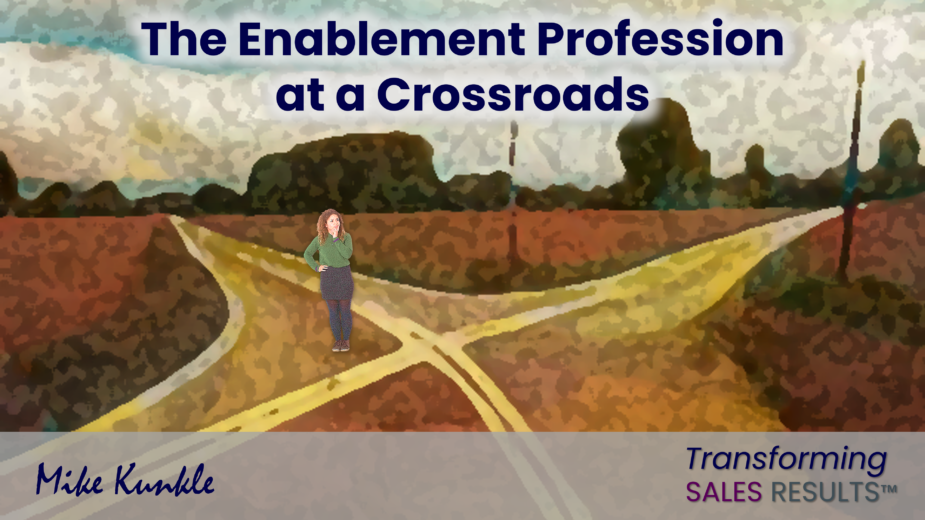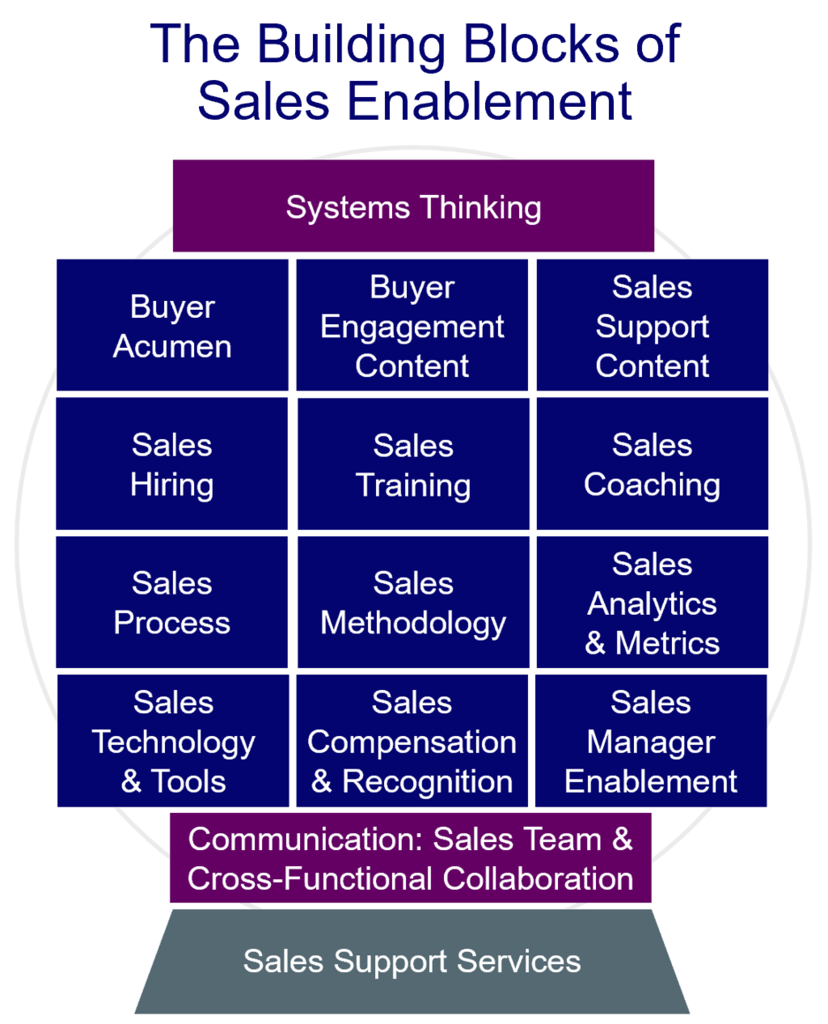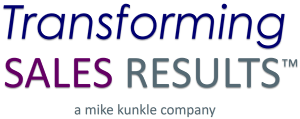The Enablement Profession at a Crossroads

In the ever-evolving landscape of business, the Sales Enablement profession has reached a pivotal crossroads. To firmly establish the function as required and themselves as integral players in their companies, enablement experts must be equipped to prove their worth by improving sales results and bolstering profitability. They must show that they can make an impact with enablement and move the needle on the metrics that matter most. This applies to the enablement profession as a whole, regardless of name – Sales Enablement, Revenue Enablement, Buying Enablement, Performance Consulting, or even Sales Training and our Sales Operations and Revenue Operations partners.
At the same time, a unique set of challenges complicates this mission. Enablement professionals don’t market, they don’t sell, and we don’t directly manage front-line sellers nor sales managers. It’s a classic case of influence without authority. This has caused some in the profession to almost lobby against being held accountable, citing that there is only so much they can do. They focus on sales competencies and behavior change only, putting accountability on the sellers and sales force leaders to improve their numbers.
To be clear, I applaud the focus on sales competencies, behavior change, and providing the other support needed for sales success – the right buyer acumen, sales process, methodology, content, tools, coaching, environment, systems, and more – all the components of The Building Blocks of Sales Enablement. And it’s true that we can provide all the foundational knowledge, tools, and skills training, and a sales force that’s poorly led may not maximize what they’re given or improve results. But there is much an enabler can do to lead the change projects, garner the support needed, and continue to nudge, push, cajole, and lead the way to making a business impact. It is not always easy, but it is entirely possible. (And, in fairness, there are plenty of sales leaders who work hand-in-hand with sales or revenue enablement and our sales or revenue operations brethren.)
This delicate balance for enablers demands a strategic approach that hinges on:
- Securing top-down support
- Nurturing cross-functional collaboration
- Fostering alignment
- Connecting the dots between enablement initiatives and their executive team’s strategic objectives and their senior sales leader’s desired outcomes
- Keeping everyone focused until adoption and behavior change foster mastery, which will deliver the results everyone wants (which must be measured).
Which brings us back to…
The Challenge of Influence Without Authority
Enablement professionals frequently find themselves in this paradoxical position. Through top-performer analysis, root-cause diagnosis, and other gap analysis methods, we often possess the knowledge to shape sales strategy, process, methodology, and how our sellers can go to market more effectively. Yet, while we can exert influence, we lack the authority to direct sales teams to take specific actions or change behaviors.
This conundrum can breed skepticism, both within the enablement team (as mentioned above) and from the stakeholders in their organization. Some might question the efficacy of these enablement professionals, even though they can’t personally direct the course of the front-line sellers and their managers. And there are plenty of enablers who succumb to imposter syndrome.
As an example of the challenges we face, we’ve recently seen a rash of downsizings in the SaaS vertical that included many enablement pros. At least in those organizations, the enablement team was not seen as critical in difficult times or able to support the sales force in getting better results in a crunch. It’s hard to tell from afar how much of that was poor leadership versus poor enablement, but in some cases where I knew the enablement pros who were impacted, I can vouch that they were solid enablement leaders, and were hamstrung by their circumstances and their leadership, not their capabilities.
In either case, this is a challenge that demands a fresh perspective and a nuanced strategy.
- Influence from Within: Influence, when wielded effectively, can be a powerful catalyst for change. Instead of succumbing to fear, uncertainly, and doubt, enablement professionals must recognize that our unique vantage point equips us with valuable insights and perspectives that can’t be easily gleaned from within the trenches. We see the larger picture and are well-positioned to drive transformative shifts by advocating for best practices, disseminating the right knowledge, supporting behavior change, closing performance gaps, and fostering a culture of continuous learning and improvement.
- Embrace Collaborative Leadership: Enablement professionals should see their roles as collaborative leadership positions. While we may not directly manage sales teams, we can champion initiatives that align with organizational objectives. By collaborating and aligning with sales leaders, managers, and the sellers themselves, we can study best practices and act as catalysts for change. We can leverage this influence to support front-line sales managers in bringing about meaningful improvements that tie to strategic objectives and desired outcomes. And we can garner support across functions to better support the sales force, as they support their buyers and customers.
The Imperative of Top-Down Support and Alignment
To navigate the path forward, enablement professionals must first secure unwavering top-down support and foster alignment across the organization. Without the backing of senior executives and sales leaders, any efforts to drive change are bound to fizzle and fall flat.
- Create a Vision: Enablement professionals should strive to articulate a clear and compelling vision of the value we bring to the organization. This vision should highlight how our contributions lead to enhanced sales outcomes, improved profitability, and a sustainable competitive advantage. The ability to convey this vision can rally senior leaders and front-line stakeholders alike behind our initiatives.
- Build Alliances: Alignment doesn’t occur in a vacuum. Enablement experts must actively seek to forge alliances with sales leaders, operations, marketing, and other departments. I often refer to them as “The Bricks in the Wall.” This cross-functional collaboration paves the way for integrated strategies that harness the collective power of various teams to achieve common goals.
Measuring Impact and Navigating Skepticism
Enablement professionals face the challenge of substantiating their efforts and proving the impact they bring to the table. While measurement might be daunting, it’s an essential component for gaining credibility and buy-in from senior leaders. I have often joked that all evaluation and attribution efforts are lies – and what you must do is get everyone to agree on which lies you will all believe. That’s hyperbole and humor, to make a point, but it’s not far from the truth. It also hints at the strategy and political approach that we must take with our measurement efforts.
- Align Around Metrics: An aligned and agreed-upon strategy for measurement is critical. Enablement professionals must work collaboratively with senior leaders to define key performance indicators (KPIs) that resonate across the organization. These KPIs should be holistic, encompassing both tangible outcomes (like revenue growth) and intangible ones (like improved sales team morale). Hopefully, these are already identified in the current strategic plan and objectives, with KPI goals and the metrics that matter most already in place.
- Embrace Data and Analytics: Enablement professionals should embrace data-driven decision-making. Leveraging analytics to track the impact of enablement initiatives allows for informed adjustments and continuous improvement. Tangible data not only bolsters credibility but also provides insights for refining strategies.
- Address Skepticism Head-On: Skepticism is natural when change is afoot, especially in roles defined by influence rather than authority. To combat this, enablement professionals must transparently communicate their vision, objectives, and progress. We should encourage open dialogue, inviting questions and concerns to foster a culture of trust and collaboration. Measurement plans should be agreed-on, not just created by enablement in a vacuum. Nothing will destroy credibility faster.
What Enablers Must Do to Start
If enablers want to be successful and continue working in their chosen profession, they must start to do the following:
- Change Your Mindset First: Enablers need to stop thinking of themselves as order takers and start thinking of themselves as strategic partners. We need to be proactive in identifying and addressing sales challenges, and they need to be willing to challenge the status quo.
- Decide to be Accountable: Enablers need to be willing to be held accountable for their results. We need to be able to articulate what we are responsible for and how we will measure success (and gain agreement and sign-off on the plan).
- Get Buy-in From Senior Leadership: Enablers need to ensure that senior leadership understands the value of sales enablement and is committed to supporting it. We need to be able to articulate how sales enablement can help (and is helping) the company achieve its sales goals.
- Collaborate with Cross-functional Teams: Enablers need to work closely with sales, marketing, product, and other teams to ensure that everyone is aligned on the sales enablement strategy. We need to be able to get input from these teams and incorporate their feedback into their plans.
- Agree on How to Measure Impact: Enablers need to be able to measure the impact of their work on sales results. We need to track metrics such as quota attainment, lead conversion rates, win rates, sales velocity. sales productivity, and customer satisfaction.
- Recognize This Work is Change Management: Almost everything we do in enablement – or even just in business in general, and certainly for performance improvement work – all requires someone to take action or do something differently. We’re in the business of getting people to change their behaviors. It might be a simple task like using a new piece of collateral that buyers like better, or it might be a complex set of skills and behaviors, like conducting a situation assessment, or facilitating a pre-planned meeting. But it’s all about behavior change. When we recognize this, it changes our perspective about the work we do and how we must do it.
The Bridge to Success: An Aligned Strategy
At its core, the journey toward enablement success is intricately tied to the development and execution of a well-aligned sales strategy. The strategy and objectives inform every facet of the enablement plan – from fostering collaboration to measuring impact. Without tying our work to a strategic roadmap, enablement will be adrift in a sea of ambiguity and will not be able to make an impact. There is a proven-effective path forward, though. And this is it:
- Define Clear Objectives: A successful enablement strategy hinges on well-defined objectives. These should be rooted in business outcomes, such as revenue growth, increased win rates, or enhanced customer satisfaction. Clear objectives create a roadmap for action and provide a tangible benchmark for measuring success. As already discussed, these should come directly from the executive team and senior sales leader.
- Start with a Sales Enablement Charter: Get aligned with your cross-functional collaborators on how you are going to support your sales force in supporting your buyers and customers.
- Conduct a Situation Assessment of the Sales Force: This assessment documents the current state of the sales force compared to the desired future state, which should align with the strategic objectives and desired outcomes. Document COIN-OP, or the Challenges, Opportunities, and Impacts in the current state, the Outcomes and Priorities in the desired future state, and the Needs, or what’s required to close the gap between the two states. (I understand that’s technically COIOPN, as I just explained it, but the Needs do bridge the gap, and COIN-OP is a cooler acronym.)
- Conduct a Building Blocks Gap Analysis: Then analyze and rate the current and desired future state of The Building Blocks of Sales Enablement, or at least the ones required to support the journey from the current to desired future state. This will help you prioritize the blocks by their importance to the plan, and also help you decide which ones are GEFN (good enough for now) and which you need to work on.
- Conduct a Force Field Analysis: Then with all those inputs, conduct a force field analysis to document the driving forces, restraining forces, and weights of each. Spend time getting this right, because in the next step, it builds your plan for you.
- Build Your Sales Enablement Plan: With the force field analysis completed, ask yourself two questions to forge a meaningful plan: 1) What can we do to reduce or eliminate the restraining forces that are holding us back? and 2) What can we do to add or strengthen the driving forces that are propelling us forward? The answers become your sales enablement plan (action plan), that is aligned to the strategic objectives and outcomes that the executive team and senior sales leader need to achieve.
- Use Phased Plans: Most transformations aren’t achieved in a single effort. It’s like the old joke about how you can eat an elephant. The answer is, one bite at time. This is all part of the above advice, to treat your work as a change management project – because it is.
- Use a Continuous Improvement Loop: An effective enablement strategy is a dynamic one that continually evolves to meet changing organizational needs. Plan, execute, measure, evaluate, and adjust in a continuous loop, until your goals are achieved. Remember that you can’t evaluate or attribute in a vacuum. You must get agreement upfront about how you will evaluate and attribute, with feedback from those to whom you’ll be presenting the results. Failure to do this will put your credibility at risk. When you achieve the results you need, or at least for this phase of the multi-phased plan, then go through the above steps in this section for each major planning session. It works!
- Use Storytelling for Success: Enablement professionals must become adept storytellers, weaving narratives that highlight their contributions and the resulting positive impact on sales outcomes. Storytelling not only communicates value but also resonates with stakeholders on a human level.
For more detail on this process to establish or evolve an enablement function that makes an impact, consider:
These Resources
- This Book: The Building Blocks of Sales Enablement
- This eBook: How to Develop a Sales Enablement Plan That Delivers Results!
- This Course: The Building Blocks of Sales Enablement Learning Experience
These Related Videos
- Video: Make An Impact With Enablement – It IS Possible!
- Video: Enablement Ignorance – How to Win Against It!
- Video: Sales Enablement vs Sales Performance Consulting
Conclusion: Embracing Influence and Forging Impact
The crossroads at which Sales and Revenue Enablement professionals stand demands a decisive shift in perspective and approach. By embracing their role as influencers, forging alliances, and crafting an aligned strategy, enablement experts can transcend the challenge of limited authority. This journey requires courage, adaptability, and a commitment to continuous improvement. As enablement professionals navigate this complex landscape, they have the opportunity to redefine their impact, foster collaboration, and ultimately, pave the way for transformative success in our profession.
I hope this post has been helpful. If you’d like to talk about any of these concepts or get some guidance, you know how to find me.
Thanks for reading, be safe out there, and by all means… let’s continue to elevate our sales profession and #MakeAnImpact With #Enablement!
Mike
Follow my work and connect
- The Building Blocks of Sales Enablement Book: https://bit.ly/BBofSE
- Sales Enablement Straight Talk Newsletter: https://bit.ly/MikeKunkle-LinkedInNewsletter
- The Building Blocks of Sales Enablement Course: https://GoFFWD.com/Blocks
- SPARXiQ Blog: https://sparxiq.com/author/mikekunkle
- Distribution Strategy Group Blog: https://distributionstrategy.com/author/mike-kunkle/
- Sales Effectiveness Straight Talk Webinars: https://bit.ly/MikeKunkle-OnDemand(60 Free Recorded Webinars)
- LinkedIn Articles: http://bit.ly/MK-LinkedInArticles
- LinkedIn Profile: https://www.linkedin.com/in/mikekunkle
- X (formerly Twitter): https://twitter.com/mike_kunkle
- Instagram: https://www.instagram.com/mike_kunkle/
- TikTok: https://www.tiktok.com/@mike_kunkle
- YouTube: https://www.youtube.com/@MikeKunkle/videos (Please Subscribe!)
About Mike
Mike Kunkle is a recognized expert on sales training, sales effectiveness, and sales enablement. He’s spent over 30 years helping companies drive dramatic revenue growth through best-in-class training strategies and proven-effective sales transformation systems – and he’s delivered impressive results for both employers and clients. Mike is the founder of Transforming Sales Results, LLC and works as the Vice President of Sales Effectiveness Services for SPARXiQ, where he designs sales training, delivers workshops, and helps clients improve sales results through a variety of sales effectiveness services. Mike collaborated with Doug Wyatt to develop SPARXiQ’s Modern Sales Foundations™ curriculum and also authored the SPARXiQ’s Sales Coaching Excellence™ course. His book, The Building Blocks of Sales Enablement, is available on Amazon and The Building Blocks of Sales Enablement Learning Experience is available through FFWD.


